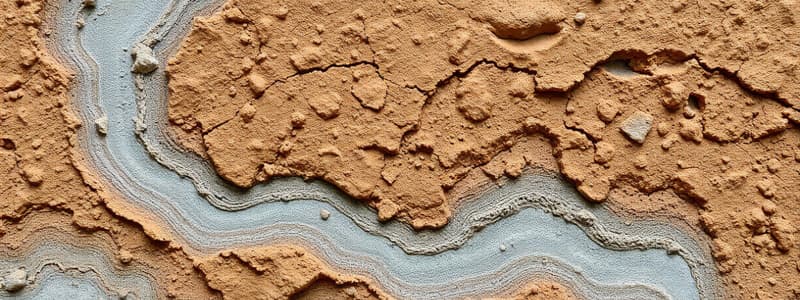Podcast
Questions and Answers
What primarily causes convection currents in fluids?
What primarily causes convection currents in fluids?
Which type of rock are fossils typically formed from?
Which type of rock are fossils typically formed from?
Which type of fossil forms from the actual remains of an organism being preserved?
Which type of fossil forms from the actual remains of an organism being preserved?
What is the main purpose of absolute age dating?
What is the main purpose of absolute age dating?
Signup and view all the answers
What is an index fossil?
What is an index fossil?
Signup and view all the answers
What is the primary purpose of radiocarbon dating?
What is the primary purpose of radiocarbon dating?
Signup and view all the answers
Which principle states that the oldest layer in an undisturbed sequence is at the bottom?
Which principle states that the oldest layer in an undisturbed sequence is at the bottom?
Signup and view all the answers
What type of fossil provides the best information for relative dating?
What type of fossil provides the best information for relative dating?
Signup and view all the answers
What is thermoluminescence dating mainly used for?
What is thermoluminescence dating mainly used for?
Signup and view all the answers
Which of the following describes impression fossils?
Which of the following describes impression fossils?
Signup and view all the answers
Study Notes
Heat Transfer - Convection
- Convection currents are formed by the uneven heating of fluids (liquids and gases)
- Heated fluids become less dense, causing them to rise
- Cooler, denser fluids replace the rising fluids
- Examples of convection currents: sea breezes, hot soup in a cup, campfire heat
Fossil Formation
- Fossils are preserved remains of once-living organisms
- Paleontologists study fossils
- Fossils are typically formed in sedimentary rock
- Fossil formation requires hard parts like bones or shells because soft tissue decays
Types of Fossils
- Petrified fossils: original material is replaced by minerals
- Mold and cast fossils: impression of organism filled with sediment
- Carbon film fossils: thin layer of carbon remains
- Trace fossils: preserved signs of activity like footprints or burrows
- Preserved remains: organism trapped in amber, ice, or tar
- Compression fossils: flattened remains preserved in rock
- Impression fossils: imprint of organism left behind
- Pseudo fossils: naturally occurring patterns that resemble fossils
Absolute Age Dating
- Measures the actual age of a material in years
- Methods include:
- Thermoluminescence dating: measures radiation emitted from material
- Radiocarbon dating: measures isotopes of carbon
- Dendrochronology dating: counts tree rings
Index Fossils
- Remains of organisms that existed for a short time period and were geographically widespread
- Used for relative dating - determining the order of events without knowing the exact age
- Examples: ammonites, trilobites, and graptolites
- The principle of fossil succession states that specific fossil assemblages only occur during specific time periods
- Index fossils are used alongside the principle of superposition to correlate rock layers and estimate their age
The Fossil Record
- Collection of fossils that document the history of life on Earth
- Provides evidence of extinct species
- Fossil types include:
- Trace fossils: preserves animal activity or behavior
- Fossils with preserved organic material: bones and shells
- Mineralized fossils: bones and shells replaced by minerals
- Impression fossils: impressions left behind by leaves, bark, hair, or feathers
- Molecular fossils: evidence of microbial life
- Fossils are dated using relative dating or absolute dating
- The fossil record is important for understanding Earth's past, as humans have only existed for a small fraction of Earth's history.
Studying That Suits You
Use AI to generate personalized quizzes and flashcards to suit your learning preferences.
Description
Test your knowledge on heat transfer through convection and the various aspects of fossil formation. This quiz covers convection currents, methods of fossilization, and different types of fossils found in nature. Challenge yourself and deepen your understanding of these important science concepts!




